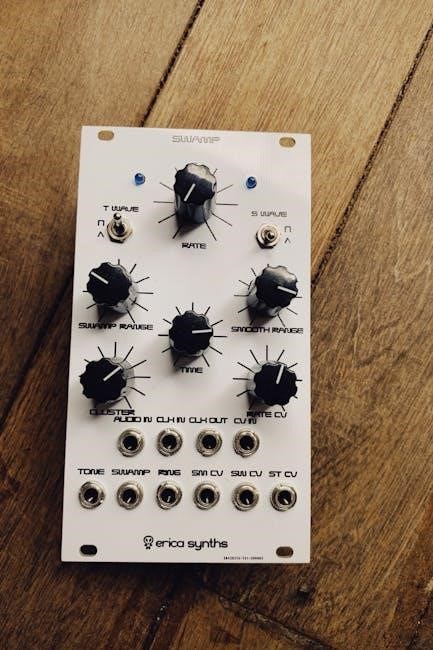The Honeywell Equipment Interface Module (EIM) is a crucial component designed to connect HVAC systems with thermostats and sensors, enabling seamless communication and efficient system control.
1.1 Overview of the EIM and Its Purpose
The Honeywell Equipment Interface Module (EIM) is a essential component designed to integrate HVAC systems with thermostats and sensors, enabling seamless communication and control. It serves as a bridge between the heating, cooling, and ventilation systems, ensuring efficient operation. The EIM supports systems like Prestige and VisionPRO IAQ, offering precise control and compatibility with Honeywell models such as THM5421R. Its primary purpose is to enhance system performance and user convenience.
1.2 Key Features of the Honeywell EIM
The Honeywell EIM is designed for seamless integration with HVAC systems, offering wireless communication and a user-friendly interface. It features a built-in relay and antenna for efficient system control. The module supports multiple heating and cooling stages, ensuring compatibility with various thermostats. Its compact design and customizable settings enhance flexibility, making it a reliable solution for both residential and commercial applications.

Key Components of the Honeywell EIM
The Honeywell EIM includes a relay for system control and an antenna for wireless communication, ensuring efficient integration with HVAC systems and thermostats.
2.1 Relay and Antenna Configuration
The Honeywell EIM features a relay for controlling HVAC systems and an antenna for wireless communication. The relay enables precise system control, while the antenna ensures reliable signal transmission. Proper configuration requires mounting the antenna at least 20 cm away from personnel and avoiding co-location with other transmitters to comply with FCC and IC exposure limits.
2.2 Compatibility with HVAC Systems
The Honeywell EIM is designed to integrate seamlessly with a wide range of HVAC systems, including Prestige IAQ and VisionPRO models. It supports up to 4 Heat/2 Cool configurations, ensuring compatibility with various residential and light commercial applications. The module works alongside thermostats like the THM5421C, providing precise control and enhancing system performance.

Installation Instructions for the Honeywell EIM
The Honeywell EIM must be installed by a trained technician, ensuring proper mounting and wiring. Follow the manual to link the thermostat and ensure power connections are secure.
3.1 Mounting and Wiring Requirements
The Honeywell EIM requires secure mounting, ideally in the wiring compartment of the baseboard heater or a DIN-rail. Proper wiring ensures system compatibility, with terminals connected to the thermostat’s C and R terminals or a separate 24V power source. Ensure all connections are tight to avoid signal interference and maintain reliable communication between components. Always refer to the manual for specific wiring diagrams.
3.2 Linking the Thermostat to the EIM
To link the thermostat to the EIM, press and quickly release the CONNECT button on the EIM. Ensure the thermostat is in linking mode. The EIM and thermostat will synchronize, establishing communication. Verify the connection by checking the status indicators or through the thermostat’s interface. Proper linking ensures seamless control and functionality of HVAC systems. Follow manual instructions for troubleshooting if synchronization fails.

Safety and Compliance Information
The Honeywell EIM complies with FCC and IC RF exposure limits, requiring antennas to maintain a 20 cm separation from individuals to ensure safe operation.
4.1 FCC and IC RF Exposure Limits
The Honeywell EIM must comply with FCC and IC RF exposure limits to ensure safe operation. Antennas must maintain a minimum separation distance of 20 cm from all persons and not be co-located with other transmitters. This ensures compliance with general population/uncontrolled exposure limits, protecting against RF exposure risks and guaranteeing reliable performance of the equipment interface module.
4.2 Separation Distance Requirements for Antennas
To meet FCC and IC RF exposure limits, antennas connected to the Honeywell EIM must be installed at least 20 cm away from all persons. This ensures safe operation and prevents RF exposure risks. The antenna should not be co-located with other transmitters or operating simultaneously, maintaining compliance and optimal system performance. Proper installation is essential for reliable functionality.

Configuration and Setup
The Honeywell EIM requires initial setup to link with thermostats and wireless accessories. Press and release the CONNECT button on the EIM to establish communication.
5.1 Initial Setup and Calibration
The Honeywell EIM’s initial setup involves linking the thermostat and ensuring proper communication. Press and release the CONNECT button on the EIM to synchronize with wireless devices. Calibration may require adjusting settings to optimize HVAC performance, ensuring accurate temperature control and efficient system operation. Follow manual instructions for precise configuration to avoid connectivity issues and ensure reliability. Always refer to the official Honeywell guide for detailed steps.
5.2 Integrating the EIM with Other Modules
Integrating the Honeywell EIM with other modules involves connecting it to compatible systems like Prestige IAQ and VisionPRO. Ensure proper wiring and configuration to maintain seamless communication. The EIM can work alongside RedLINK accessories, such as wireless sensors and thermostats. Always follow the installation manual for specific instructions on integrating with other modules to ensure system compatibility and optimal performance. This step is crucial for a fully functional HVAC setup.

Maintenance and Troubleshooting
Regularly inspect the EIM for dust and damage. Check connections to ensure proper functionality. If issues arise, refer to the manual for diagnostic tips and reset procedures.
6.1 Routine Maintenance Checks
Perform regular visual inspections of the EIM and its connections to ensure there is no damage or corrosion. Clean the module and surrounding areas to prevent dust buildup, which can interfere with performance. Verify that all wires are securely connected and that the antenna is properly aligned for optimal signal strength. Schedule these checks quarterly to maintain reliability.
6.2 Common Issues and Diagnostic Tips
Common issues with the Honeywell EIM include poor signal strength, intermittent communication, and relay malfunctions. Check antenna separation distances and ensure no physical obstructions. Verify wiring connections and power supply for stability. If issues persist, reset the EIM and linked devices. Refer to the manual for detailed troubleshooting steps to resolve connectivity or operational problems effectively.

Manufacturer’s Instructions and Guidelines
Always follow Honeywell’s official manuals for proper installation and operation. Adhere to FCC guidelines to ensure compliance and safety. Refer to Honeywell’s support resources for assistance.
7.1 Importance of Following Installation Manuals
Adhering to Honeywell’s installation manuals is critical for proper functionality and safety. These guides provide detailed steps to ensure the Equipment Interface Module (EIM) is set up correctly. Failure to follow instructions can result in system malfunctions or safety hazards. Always refer to official documentation to guarantee compliance with FCC and IC regulations, ensuring optimal performance and reliability of the HVAC system.
7.2 Resetting RedLINK Accessories
Resetting RedLINK accessories is essential when replacing or upgrading the EIM. This process ensures proper communication between devices. To reset, press and hold the CONNECT button on the EIM until the status light flashes. Release and repeat to complete the reset. This step ensures all accessories synchronize correctly with the new module, maintaining system functionality and reliability. Always follow manual instructions for precise execution.

Compatibility and System Integration
The Honeywell EIM seamlessly integrates with Prestige IAQ and VisionPRO systems, supporting up to 4 heat and 2 cool systems for optimal HVAC control and efficiency.
8.1 Supported HVAC Systems and Thermostats
The Honeywell EIM is compatible with a wide range of HVAC systems, including Prestige IAQ and VisionPRO, supporting up to 4 heat and 2 cool configurations. It works seamlessly with Honeywell thermostats like the THM5421C, ensuring precise control and efficient system operation. This compatibility allows for versatile installations across residential and light commercial applications.
8.2 Compatibility with Prestige and VisionPRO IAQ Systems
The Honeywell EIM seamlessly integrates with Prestige IAQ and VisionPRO systems, ensuring enhanced functionality and precise control. It supports up to 4 heat and 2 cool configurations, making it ideal for advanced HVAC setups. The module’s compatibility with these systems allows for efficient integration of RedLINK wireless accessories, providing a robust and scalable solution for both residential and light commercial applications.
Advanced Features and Customization
The Honeywell EIM offers customizable settings for HVAC control, enabling tailored configurations to meet specific system requirements. Its user-friendly interface ensures easy adjustments, optimizing performance and efficiency.
9.1 Customizable Settings for HVAC Control
The Honeywell EIM allows users to tailor HVAC system settings to their preferences, including temperature ranges and operation modes. Customizable parameters ensure precise control over heating and cooling outputs, optimizing energy efficiency and comfort. These adaptable features make the EIM a versatile solution for diverse environmental needs, enhancing overall system performance and user satisfaction.
9.2 User-Friendly Interface Design
The Honeywell EIM features an intuitive interface designed for ease of use, ensuring seamless navigation through settings and controls. Its user-friendly layout simplifies complex operations, making it accessible for both professionals and homeowners. The interface supports efficient system management, enhancing the overall user experience while maintaining precise control over HVAC operations. This design prioritizes clarity and convenience, streamlining interactions.

Technical Specifications and Requirements
The Honeywell EIM operates under specific voltage and power requirements, ensuring compatibility with various HVAC systems. Its design adheres to environmental and operational constraints for optimal performance.
10.1 Power Requirements and Voltage Compatibility
The Honeywell EIM requires a 24V AC power supply, compatible with standard HVAC systems. It operates within a voltage range of 18-30V AC, ensuring reliability across diverse installations. Proper power connections are essential to avoid damage and ensure safe operation, as outlined in the manual. Always follow the specified voltage requirements to maintain optimal functionality and system performance.
10.2 Environmental and Operational Constraints
The Honeywell EIM operates effectively within a temperature range of 32°F to 122°F (0°C to 50°C) and humidity levels up to 80% RH. It must be installed in a dry, well-ventilated area, away from direct sunlight and extreme temperatures. The module should not be exposed to hazardous environments or corrosive substances. Adherence to these constraints ensures reliable performance and compliance with safety standards.

Manufacturer Support and Resources
Honeywell provides dedicated customer support and extensive online resources, including the official manual, to assist with EIM installation, troubleshooting, and maintenance, ensuring optimal performance and user satisfaction.
11.1 Accessing the Official Honeywell Manual
The official Honeywell manual for the Equipment Interface Module (EIM) is available online in PDF format, providing detailed installation, operation, and troubleshooting guidelines. Users can download it directly from Honeywell’s official website or through the customer support portal. The manual is essential for understanding system requirements and ensuring proper installation. It is recommended to leave a copy with the system owner for future reference.
11.2 Customer Support and Assistance Options
Honeywell offers comprehensive customer support for the Equipment Interface Module (EIM), including online resources, phone assistance, and email support. Users can access troubleshooting guides and FAQs on Honeywell’s official website. For direct help, contact Honeywell’s customer service team through their support portal or visit customer.honeywell.com for detailed assistance options.
The Honeywell EIM is a reliable solution for HVAC control, offering seamless integration and user-friendly operation. Its compatibility with various systems ensures performance and future enhancements.
12.1 Benefits of Using the Honeywell EIM
The Honeywell EIM offers enhanced system integration, precise control, and compatibility with various HVAC systems. Its user-friendly interface and customizable settings improve efficiency, while reliable performance ensures consistent operation. Compliance with safety standards and seamless connectivity with accessories like thermostats and sensors make it a versatile and practical choice for modern heating and cooling solutions.
12.2 Future Updates and Enhancements
Future updates for the Honeywell EIM will focus on enhancing compatibility with emerging smart home systems and improving energy efficiency. Regular firmware updates will ensure optimal performance, while potential integrations with advanced IoT platforms aim to offer users greater control and convenience. These enhancements will solidify the EIM’s role as a central hub for modern HVAC management. System compatibility, smart home integration, and user-friendly improvements are expected to be key areas of development.
